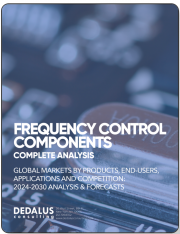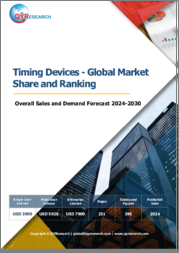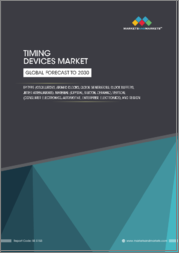
|
시장보고서
상품코드
1497728
세계의 타이밍 디바이스 시장 : 시장 규모 및 점유율 분석 - 유형별, 재료별, 용도별 - 매출 추계 및 수요 예측(-2030년)Timing Devices Market Size and Share Analysis by Type, Material, Application - Global Industry Revenue Estimation and Demand Forecast to 2030 |
||||||
주요 개요
세계의 타이밍 디바이스 시장은 2023년에 55억 1,880만 달러로 평가되었고, CAGR 7.3%의 연평균 복합 성장률로 성장할 전망이며, 2030년에는 88억 9,320만 달러로 확대될 것으로 예측됩니다. 이는 라이프 스타일을 향상시키기 위해 웨어러블 디바이스를 포함한 전자 기기에 대한 사람들의 관심이 높아지고 있기 때문입니다. 타이밍 디바이스는 이러한 전자 디바이스에 실시간으로 데이터를 전송하기 위한 신호를 제공합니다. 수정 진동자나 세라믹 공진자, MEMS에 이러한 원리를 이용함으로써 안정된 주파수의 발진을 실현할 수 있습니다.
각종 산업에서 타이밍 디바이스의 광범위한 응용도 산업의 확대를 뒷받침하고 있습니다. 타이밍 디바이스는 전자 기기, 항공우주 시스템, 자동차, 통신 등에 광범위하게 채용되고 있습니다.
투자의 형태로 기업과 정부 기관의 참여가 높아지고 있는 것은 IoT 분야의 확대에 중요한 역할을 하고 있으며, 이것이 타이밍 디바이스 산업의 확대를 뒷받침하고 있습니다. 예를 들어, 3년간의 국가 계획인 IoTUK는 5,280만 달러의 자금을 획득했습니다. 이 프로그램은 영국의 민간 부문 및 공공 부문에서 IoT의 수용 강화에 중점을 둡니다.
시장 인사이트
아시아태평양은 업계의 최대 점유율을 차지하며 향후 10년간 가장 빠른 CAGR로 더욱 성장할 것으로 보입니다. 그 중에서도 중국과 일본은 타이밍 디바이스를 필요로 하는 전자기기 및 그 부품의 산업 중심지입니다.
2023년 북미는 약 30%의 점유율을 차지했으며 향후 10년간은 대폭적인 CAGR로 추진할 것으로 보입니다. 이 배경에는 대기업의 존재, 반도체 분야의 융성, IoT의 보급, 타이밍 기술의 발전, 다양한 용도로 매우 정확한 타이밍을 요구하는 요구 증가가 있습니다.
발진기 카테고리는 2023년에는 40%로 가장 큰 점유율을 차지했습니다. 특히 클럭 발진기의 카테고리는 향후 몇 년동안 CAGR이 급속히 상승할 전망입니다. 또한 2023년에는 수정 진동자가 60%의 점유율로 업계를 선도하고 있습니다. 그 이유는 정밀도가 높고 수명이 길고 안정성이 높고 주파수 내성이 우수하기 때문입니다.
실리콘은 향후 10년 동안 가장 빠른 CAGR로 발전할 것으로 보입니다. 이는 실리콘의 전력 사용량이 적고 비교적 경제적이기 때문입니다.
소비자용 전자기기가 업계를 선도한 이유는 타이밍 디바이스가 휴대전화, 컴퓨터 등 각종 소비자용 제품에서 주로 이용되고 있기 때문입니다. 이러한 디바이스는 정보를 적절한 속도 및 시간으로 전송하고 조정하기 위한 타이밍 신호를 제공합니다.
통신 카테고리는 급속한 CAGR로 발전할 것으로 보입니다. 그 이유는 타이밍 디바이스가 한 장치에서 다른 장치로의 데이터 전송을 동기화하기 위해 통신에 사용되기 때문입니다. 이는 효율적이고 신뢰할 수 있는 데이터 전송을 보장하는 데 중요하며 현대 생활의 모든 측면이 이에 의존합니다.
본 보고서에서는 세계의 타이밍 디바이스 시장에 대해 분석하고, 시장의 기본 구조 및 최신 정세와 주요한 촉진요인, 억제요인, 세계 전체 및 지역별 및 주요국 시장 규모의 동향 전망(금액 기준, 2017-2030년), 유형별, 재료별, 용도별 상세 동향, 현재 시장 경쟁의 상황, 주요 기업프로파일 등의 정보를 전해드립니다.
목차
제1장 조사 범위
제2장 조사 방법
제3장 주요 요약
제4장 시장 지표
제5장 업계 전망
- 시장 역학
- 동향
- 성장 촉진요인
- 억제요인 및 과제
- 성장 촉진요인 및 억제요인의 영향 분석
- 신형 코로나 바이러스 감염(COVID-19)의 영향
- Porter's Five Forces 분석
- 세계의 타이밍 디바이스 시장에서의 성장 기회
- 기술 분석
- 가격 분석
제6장 세계 시장
- 개요
- 시장 수익 : 유형별(2017-2030년)
- 시장 수익 : 재료별(2017-2030년)
- 시장 수익 : 용도별(2017-2030년)
- 시장 수익 : 지역별(2017-2030년)
제7장 북미 시장
- 개요
- 시장 수익 : 유형별(2017-2030년)
- 시장 수익 : 재료별(2017-2030년)
- 시장 수익 : 용도별(2017-2030년)
- 시장 수익 : 국가별(2017-2030년)
제8장 유럽 시장
제9장 아시아태평양 시장
제10장 라틴아메리카 시장
제11장 중동 및 아프리카 시장
제12장 미국 시장
- 개요
- 시장 수익 : 유형별(2017-2030년)
- 시장 수익 : 재료별(2017-2030년)
- 시장 수익 : 용도별(2017-2030년)
제13장 캐나다 시장
제14장 독일 시장
제15장 프랑스 시장
제16장 영국 시장
제17장 이탈리아 시장
제18장 스페인 시장
제19장 일본 시장
제20장 중국 시장
제21장 인도 시장
제22장 호주 시장
제23장 한국시장
제24장 브라질 시장
제25장 멕시코 시장
제26장 사우디아라비아 시장
제27장 남아프리카 시장
제28장 아랍에미리트(UAE) 시장
제29장 경쟁 구도
- 시장 진출기업 및 제공 품목의 일람
- 주요 기업의 경쟁 벤치마킹
- 주요 기업의 제품 벤치마킹
- 최근의 전략 전개 상황
제30장 기업 프로파일
- Rakon Limited
- KYOCERA Corporation
- TXC Corporation
- NXP Semiconductors NV
- Microchip Technology Inc.
- Infineon Technologies AG
- Renesas Electronics Corporation
제31장 부록
AJY 24.06.28Key Highlights
The timing devices market was USD 5,518.8 million in 2023, and it will rise to USD 8,893.2 million, propelling at a 7.3% compound annual growth rate, by 2030.
This can be because of the rising interest of populations in electronic goods, including wearable devices, to enhance their lifestyle.
Timing devices offer such electronic devices with signals for transmitting data in real time.
Using these principles in quartz crystals, ceramic resonators, and MEMSs makes it feasible to create oscillations with steady frequencies.
The extensive applications of timing devices in different industries are also aiding the industry expansion.
Timing devices are extensively employed in electronic equipment, aerospace systems, automobiles, and telecommunications.
The rising involvement of industry players and government bodies in the form of investment plays an important part in the expansion of the IoT sector, which, in line, boosts the expansion of the timing devices industry.
The IoTUK, a 3-year national plan, obtained funding of USD 52.8 million.
The program focused on enhancing the acceptance of IoT in the private and public sectors in the U.K.
It enhanced IoT entrepreneurship and enabled partnerships among businesses in different sectors.
Market Insights
APAC accounted for the largest share of the industry, and it will further advance at the fastest CAGR during this decade. China led the industry in APAC owing to the existence of numerous electronics and automotive firms.
China and Japan are industrial centers for electronic devices as well as their parts, which need timing devices.
In 2023, North America accounted for approximately 30% share, and it will propel at a significant compound annual growth rate during this decade.
This is because of the existence of major companies, the flourishing semiconductor sector, mounting IoT acceptance, developing timing technologies, and the rising need for very accurate timing in different applications.
The oscillators category was the largest contributor to the industry in 2023, with a 40% share. Businesses are increasing their offering with novel and innovative types of oscillators.
The clock generator category will advance at a rapid CAGR in the coming years, because of the increasing level of improvements in these devices.
Crystals led the industry in 2023, with a 60% share. This can be because of their great precision, long service life, great stability, and outstanding frequency tolerance.
Silicon will advance at the fastest compound annual growth rate during this decade. This will be because of the low electricity usage and relatively economical nature of silicon.
Silicon-MEMS-based timing devices provide great reliability, robust vibration and shock resistance, and extensive operating temperatures.
Consumer electronics led the industry because timing devices are largely utilized in cell phones, computers, and various other consumer products.
Here, these devices offer timing signals for transmitting information at the right speed and time and for coordinating.
The telecommunications category will advance at a rapid CAGR. This is because timing devices are employed in telecommunications to synchronize data transmission from one device to another.
This is important for guaranteeing efficient and reliable data transmission, on which all aspects of contemporary life depend.
Table of Contents
Chapter 1. Research Scope
- 1.1. Research Objectives
- 1.2. Market Definition
- 1.3. Analysis Period
- 1.4. Market Size Breakdown by Segments
- 1.4.1. Market size breakdown, by type
- 1.4.2. Market size breakdown, by material
- 1.4.3. Market size breakdown, by application
- 1.4.4. Market size breakdown, by region
- 1.4.5. Market size breakdown, by country
- 1.5. Market Data Reporting Unit
- 1.5.1. Value
- 1.6. Key Stakeholders
Chapter 2. Research Methodology
- 2.1. Secondary Research
- 2.1.1. Paid
- 2.1.2. Unpaid
- 2.1.3. P&S Intelligence database
- 2.2. Primary Research
- 2.3. Market Size Estimation
- 2.4. Data Triangulation
- 2.5. Currency Conversion Rates
- 2.6. Assumptions for the Study
- 2.7. Notes and Caveats
Chapter 3. Executive Summary
Chapter 4. Market Indicators
Chapter 5. Industry Outlook
- 5.1. Market Dynamics
- 5.1.1. Trends
- 5.1.2. Drivers
- 5.1.3. Restraints/challenges
- 5.1.4. Impact analysis of drivers/restraints
- 5.2. Impact of COVID-19
- 5.3. Porter's Five Forces Analysis
- 5.3.1. Bargaining power of buyers
- 5.3.2. Bargaining power of suppliers
- 5.3.3. Threat of new entrants
- 5.3.4. Intensity of rivalry
- 5.3.5. Threat of substitutes
- 5.4. Growth Opportunities in Global Timing Devices Market
- 5.5. Technology Analysis
- 5.6. Pricing Analysis
Chapter 6. Global Market
- 6.1. Overview
- 6.2. Market Revenue, by Type (2017-2030)
- 6.3. Market Revenue, by Material (2017-2030)
- 6.4. Market Revenue, by Application (2017-2030)
- 6.5. Market Revenue, by Region (2017-2030)
Chapter 7. North America Market
- 7.1. Overview
- 7.2. Market Revenue, by Type (2017-2030)
- 7.3. Market Revenue, by Material (2017-2030)
- 7.4. Market Revenue, by Application (2017-2030)
- 7.5. Market Revenue, by Country (2017-2030)
Chapter 8. Europe Market
- 8.1. Overview
- 8.2. Market Revenue, by Type (2017-2030)
- 8.3. Market Revenue, by Material (2017-2030)
- 8.4. Market Revenue, by Application (2017-2030)
- 8.5. Market Revenue, by Country (2017-2030)
Chapter 9. APAC Market
- 9.1. Overview
- 9.2. Market Revenue, by Type (2017-2030)
- 9.3. Market Revenue, by Material (2017-2030)
- 9.4. Market Revenue, by Application (2017-2030)
- 9.5. Market Revenue, by Country (2017-2030)
Chapter 10. LATAM Market
- 10.1. Overview
- 10.2. Market Revenue, by Type (2017-2030)
- 10.3. Market Revenue, by Material (2017-2030)
- 10.4. Market Revenue, by Application (2017-2030)
- 10.5. Market Revenue, by Country (2017-2030)
Chapter 11. MEA Market
- 11.1. Overview
- 11.2. Market Revenue, by Type (2017-2030)
- 11.3. Market Revenue, by Material (2017-2030)
- 11.4. Market Revenue, by Application (2017-2030)
- 11.5. Market Revenue, by Country (2017-2030)
Chapter 12. U.S. Market
- 12.1. Overview
- 12.2. Market Revenue, by Type (2017-2030)
- 12.3. Market Revenue, by Material (2017-2030)
- 12.4. Market Revenue, by Application (2017-2030)
Chapter 13. Canada Market
- 13.1. Overview
- 13.2. Market Revenue, by Type (2017-2030)
- 13.3. Market Revenue, by Material (2017-2030)
- 13.4. Market Revenue, by Application (2017-2030)
Chapter 14. Germany Market
- 14.1. Overview
- 14.2. Market Revenue, by Type (2017-2030)
- 14.3. Market Revenue, by Material (2017-2030)
- 14.4. Market Revenue, by Application (2017-2030)
Chapter 15. France Market
- 15.1. Overview
- 15.2. Market Revenue, by Type (2017-2030)
- 15.3. Market Revenue, by Material (2017-2030)
- 15.4. Market Revenue, by Application (2017-2030)
Chapter 16. U.K. Market
- 16.1. Overview
- 16.2. Market Revenue, by Type (2017-2030)
- 16.3. Market Revenue, by Material (2017-2030)
- 16.4. Market Revenue, by Application (2017-2030)
Chapter 17. Italy Market
- 17.1. Overview
- 17.2. Market Revenue, by Type (2017-2030)
- 17.3. Market Revenue, by Material (2017-2030)
- 17.4. Market Revenue, by Application (2017-2030)
Chapter 18. Spain Market
- 18.1. Overview
- 18.2. Market Revenue, by Type (2017-2030)
- 18.3. Market Revenue, by Material (2017-2030)
- 18.4. Market Revenue, by Application (2017-2030)
Chapter 19. Japan Market
- 19.1. Overview
- 19.2. Market Revenue, by Type (2017-2030)
- 19.3. Market Revenue, by Material (2017-2030)
- 19.4. Market Revenue, by Application (2017-2030)
Chapter 20. China Market
- 20.1. Overview
- 20.2. Market Revenue, by Type (2017-2030)
- 20.3. Market Revenue, by Material (2017-2030)
- 20.4. Market Revenue, by Application (2017-2030)
Chapter 21. India Market
- 21.1. Overview
- 21.2. Market Revenue, by Type (2017-2030)
- 21.3. Market Revenue, by Material (2017-2030)
- 21.4. Market Revenue, by Application (2017-2030)
Chapter 22. Australia Market
- 22.1. Overview
- 22.2. Market Revenue, by Type (2017-2030)
- 22.3. Market Revenue, by Material (2017-2030)
- 22.4. Market Revenue, by Application (2017-2030)
Chapter 23. South Korea Market
- 23.1. Overview
- 23.2. Market Revenue, by Type (2017-2030)
- 23.3. Market Revenue, by Material (2017-2030)
- 23.4. Market Revenue, by Application (2017-2030)
Chapter 24. Brazil Market
- 24.1. Overview
- 24.2. Market Revenue, by Type (2017-2030)
- 24.3. Market Revenue, by Material (2017-2030)
- 24.4. Market Revenue, by Application (2017-2030)
Chapter 25. Mexico Market
- 25.1. Overview
- 25.2. Market Revenue, by Type (2017-2030)
- 25.3. Market Revenue, by Material (2017-2030)
- 25.4. Market Revenue, by Application (2017-2030)
Chapter 26. Saudi Arabia Market
- 26.1. Overview
- 26.2. Market Revenue, by Type (2017-2030)
- 26.3. Market Revenue, by Material (2017-2030)
- 26.4. Market Revenue, by Application (2017-2030)
Chapter 27. South Africa Market
- 27.1. Overview
- 27.2. Market Revenue, by Type (2017-2030)
- 27.3. Market Revenue, by Material (2017-2030)
- 27.4. Market Revenue, by Application (2017-2030)
Chapter 28. U.A.E. Market
- 28.1. Overview
- 28.2. Market Revenue, by Type (2017-2030)
- 28.3. Market Revenue, by Material (2017-2030)
- 28.4. Market Revenue, by Application (2017-2030)
Chapter 29. Competitive Landscape
- 29.1. List of Market Players and their Offerings
- 29.2. Competitive Benchmarking of Key Players
- 29.3. Product Benchmarking of Key Players
- 29.4. Recent Strategic Developments
Chapter 30. Company Profiles
- 30.1. Rakon Limited
- 30.1.1. Business overview
- 30.1.2. Product and service offerings
- 30.1.3. Key financial summary
- 30.2. KYOCERA Corporation
- 30.2.1. Business overview
- 30.2.2. Product and service offerings
- 30.2.3. Key financial summary
- 30.3. TXC Corporation
- 30.3.1. Business overview
- 30.3.2. Product and service offerings
- 30.3.3. Key financial summary
- 30.4. NXP Semiconductors N.V.
- 30.4.1. Business overview
- 30.4.2. Product and service offerings
- 30.4.3. Key financial summary
- 30.5. Microchip Technology Inc.
- 30.5.1. Business overview
- 30.5.2. Product and service offerings
- 30.5.3. Key financial summary
- 30.6. Infineon Technologies AG
- 30.6.1. Business overview
- 30.6.2. Product and service offerings
- 30.6.3. Key financial summary
- 30.7. Renesas Electronics Corporation
- 30.7.1. Business overview
- 30.7.2. Product and service offerings
- 30.7.3. Key financial summary
Chapter 31. Appendix
- 31.1. Abbreviations
- 31.2. Sources and References
- 31.3. Related Reports



















